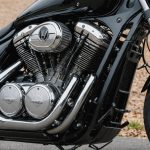Unlocking Wet Track Dominance: Key Suspension Tweaks for Optimizing Race Car Performance
When it comes to racing, particularly on wet tracks, the suspension setup of your car can be the difference between a podium finish and a disappointing result. Here’s a comprehensive guide to help you and your team optimize your car’s suspension for wet track dominance.
Understanding the Basics of Suspension in Wet Conditions
In wet conditions, the grip and stability of your car are severely compromised. The key to success lies in understanding how different suspension components interact with the track and the car’s overall dynamics.
In the same genre : Boosting engine efficiency: tailoring coolant solutions for chilly uk conditions
Natural Frequency and Suspension Stiffness
In real-life racing and sim racing, the natural frequency of the suspension is crucial. Unlike traditional spring rates, natural frequency measures the speed of shock movement and oscillations, which is affected by the entire geometry of the shock, control arms, and anti-roll bar assembly. For wet tracks, a slightly stiffer rear suspension compared to the front can improve stability and reduce the likelihood of oversteer[1].
Ride Height and Rake
Ride height and rake are critical adjustments that can drastically affect your car’s behavior. A negative rake (lower rear) can increase top speed but may compromise cornering performance. In contrast, a positive rake is generally preferred for more incisive cornering. However, it’s essential to find a balance that suits your driving style and the specific track conditions[1].
In parallel : Effective strategies to evaluate your vehicle’s lane departure warning system performance
Adjusting Suspension Components for Wet Tracks
Camber, Caster, and Toe Angles
- Camber: Negative camber (wheels tilted inward) improves cornering grip but can increase tyre wear on the inner edge. For wet tracks, a slightly reduced negative camber can help maintain grip without excessive wear.
- Caster: Caster affects the steering response. A higher caster angle can improve stability but may make the car more difficult to turn.
- Toe Angles: Toe angles, especially in the rear, significantly impact stability. A slight toe-out (wheels pointing outward) can enhance initial turn-in but may reduce stability in long corners. Conversely, toe-in (wheels pointing inward) improves stability under braking and acceleration but can increase tyre scrub and reduce straight-line speed[1].
Anti-Roll Bars and Slip Differential
- Anti-Roll Bars: These bars help in reducing body roll during cornering. For wet tracks, softer anti-roll bars can maintain better grip by allowing more suspension travel.
- Slip Differential: The slip differential controls the power distribution between the left and right wheels. In wet conditions, a more open differential setting can help in maintaining traction and stability, especially during corner exit[1].
Practical Tips for Wet Track Suspension Setup
Here are some practical tips to help you and your team set up your car for wet track dominance:
Start with the Basics
- Tyre Compound: Ensure you are using tyres optimized for wet conditions. Cars like the Acura NSX GT3 EVO 22 and BMW M2 CSR come with separate rain tire sets that are specifically designed for performance in the wet[4].
- Downforce: Adjust the front and rear wing settings to maximize downforce without compromising top speed. Starting with the front maxed out and adjusting the rear wing for high-speed balance is a good approach[1].
Fine-Tuning the Setup
- Braking Efficiency: Ensure your braking system is optimized for wet conditions. Upgraded braking components and finely tuned ABS settings, like those on the Nissan GTR GT3, can enhance stability during heavy braking zones[2].
- Suspension Adjustments: Use a computerized shock dyno to assess and adjust every aspect of your suspension, including camber, caster, bump steer, and scale-out. This level of detail can make a significant difference in how your car handles on a wet track[3].
Example Setup Guide for a Wet Track
Here’s a detailed setup guide for optimizing your car’s suspension on a wet track:
Suspension Settings
- Natural Frequency:
- Front: 10-12 Hz
- Rear: 12-14 Hz
- Ride Height:
- Front: 60 mm
- Rear: 55 mm
- Rake:
- Positive rake of about 1-2 degrees
- Camber:
- Front: -2.5 to -3.0 degrees
- Rear: -2.0 to -2.5 degrees
- Toe Angles:
- Front: 0.1 to 0.2 degrees toe-out
- Rear: 0.2 to 0.3 degrees toe-in
- Anti-Roll Bars:
- Front: Soft to medium stiffness
- Rear: Medium stiffness
- Slip Differential:
- 10-20% open differential setting
Aerodynamic Adjustments
- Front Wing: Maxed out for maximum downforce
- Rear Wing: Adjusted for high-speed balance, ensuring minimal drag impact on top speed[1].
Table: Comparative Suspension Settings for Different Cars
| Car Model | Natural Frequency (Hz) | Ride Height (mm) | Camber (degrees) | Toe Angles (degrees) | Anti-Roll Bars | Slip Differential |
|---|---|---|---|---|---|---|
| Nissan GTR GT3 | Front: 10-12, Rear: 12-14 | Front: 60, Rear: 55 | Front: -2.5 to -3.0, Rear: -2.0 to -2.5 | Front: 0.1 to 0.2 toe-out, Rear: 0.2 to 0.3 toe-in | Front: Soft to medium, Rear: Medium | 10-20% open |
| Acura NSX GT3 EVO 22 | Front: 11-13, Rear: 13-15 | Front: 65, Rear: 60 | Front: -3.0 to -3.5, Rear: -2.5 to -3.0 | Front: 0.2 to 0.3 toe-out, Rear: 0.3 to 0.4 toe-in | Front: Medium, Rear: Medium to stiff | 15-25% open |
| BMW M2 CSR | Front: 10-12, Rear: 12-14 | Front: 60, Rear: 55 | Front: -2.5 to -3.0, Rear: -2.0 to -2.5 | Front: 0.1 to 0.2 toe-out, Rear: 0.2 to 0.3 toe-in | Front: Soft to medium, Rear: Medium | 10-20% open |
Quotes from Racing Experts
- “In wet conditions, it’s all about finding that balance between grip and stability. A slightly stiffer rear suspension and optimized aerodynamics can make all the difference,” says a racing engineer from Wolf Motorsports[3].
- “The key to success on a wet track is not just about the car setup, but also about the driver’s ability to adapt. Practice and experience are crucial in understanding how the car behaves in different conditions,” notes a professional driver competing in the GT3 series.
Real-Life Examples and Anecdotes
The Nissan GTR GT3
The Nissan GTR GT3 is a prime example of a car that excels in wet conditions due to its advanced aerodynamic package and stability management systems. During a wet race at Spa-Francorchamps, a driver noted that the car’s ability to maintain grip and balance was exceptional, thanks to its optimized front splitter and large rear wing[2].
The Acura NSX GT3 EVO 22
In a recent sim racing event, a driver using the Acura NSX GT3 EVO 22 on a wet track at Monza found that adjusting the slip differential to a more open setting significantly improved traction during corner exit, leading to faster lap times and better race results[4].
Optimizing your car’s suspension for wet track conditions is a complex but rewarding process. By understanding the basics of suspension dynamics, fine-tuning your setup, and using practical tips and real-life examples, you and your team can unlock the full potential of your car and achieve dominance on the wet track.
Final Tips for the Race Weekend
- Test and Adjust: Always test your setup on the track and make adjustments based on real-time feedback.
- Driver Feedback: Work closely with your driver to understand their driving style and preferences.
- Development Programme: Continuously develop and refine your setup throughout the race season to stay competitive.
- Race Qualifying: Ensure your car is optimized for both qualifying and the race, as the conditions can vary significantly.
By following these guidelines and staying committed to continuous development, you can ensure that your car and your team are always ready to tackle the challenges of wet track racing.











